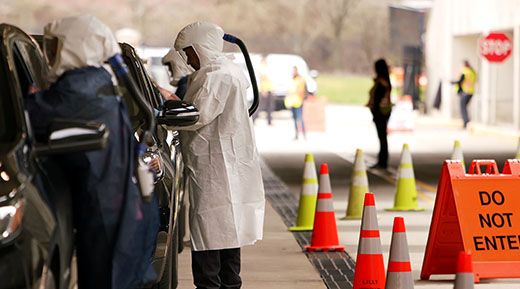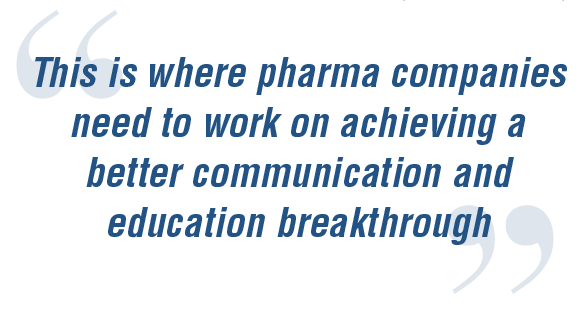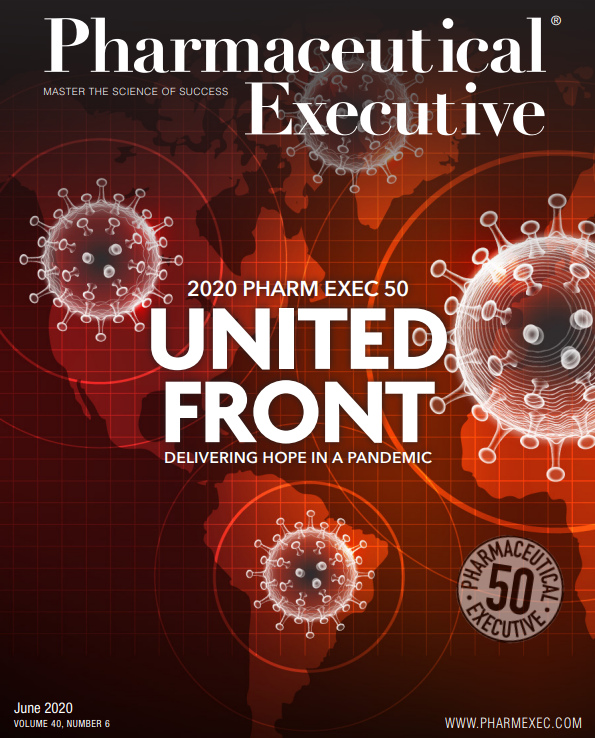Delivering Hope in a Pandemic
Pharma is boosting outreach and its image, as the industry faces a defining period in its quest to sway the tide of public perception.
Pharma boosts outreach and image amid COVID-19Â, as the industry faces a defining period in its quest to sway the tide of public perception
Last August, a Gallup Poll placed pharma at an all-time reputation low. Consumers ranked it 25th out of 25 industries, edging out the federal government for last place. It was the industry’s most abysmal finish since the annual poll began in 2001. With pricing issues and the opioid epidemic plaguing the industry, many wondered what it would take to turn things around. No one could have imagined it would be a pandemic.
About eight months later, The Harris Poll shed a ray of sunshine through the clouds of coronavirus when its research indicated pharma’s reputation was on the rise. Between March 21 and 23, the poll revealed 33% of Americans had a more positive view of the industry than they did before the pandemic began. Between April 11 and 13, that number increased to 40%, where it remained for Harris’ mid-May poll.
This upward trend seems natural due to pharma’s demonstrated dedication to finding treatments and a vaccine. But there’s something else that may be contributing to the uptick: The public is finally recognizing pharma has a heart.
What's in a name?
“This is a trend that we have also seen in our continuous tracking of major pharma companies,” says Sven Klingemann, PhD, director at the RepTrak Company (formerly Reputation Institute), a data and insights firm helping business leaders understand how their company is perceived. “When we look at the biggest drivers of positive reputational change for the pharma industry in the US, we see that increases in positive perceptions around corporate responsibility, for example, positive societal and workplace contributions as well as transparent and ethical behavior, have risen to the top.”
Sven Klingemann

The RepTrak Company’s data also indicate that the public’s emotional connection with pharma companies has increased at twice the rate compared to how they measure pharma companies on their perceived actions in domains such as innovation, products and services, corporate responsibility, and leadership.
“While we have not measured the specific impact of select contribution efforts, we know that citizenship is currently the second most important driver of reputation for the pharma industry,” says Klingemann.
What makes pharma different than other industries is that it has always had an intrinsic dedication to improving lives. As part of the shake-up coronavirus has caused the world, that caring attitude now has been able to organically float to the surface.
“I don’t think we’ve changed,” says Tiffany Benjamin, senior director of corporate social responsibility and global health for Eli Lilly and Company and president of Lilly Foundation. “I think that this has given the public a window into what we do every day. And now that people can really see all of our many different efforts, they’re impressed.”
Investing in outreach
When it comes to contributions, the greatest impact pharma has had outside of R&D has been through monetary donations to various organizations that aim to alleviate the impact of COVID-19 on communities, whether through food pantries, the supply of personal protective equipment (PPE), or education campaigns.
Lilly is one company that helped to start a COVID-specific fund along with other investors. The newly created Indianapolis e-Learning Fund recently announced $1.5 million in grants to Marion County schools to address urgent gaps in e-learning for underserved students and their families. This includes providing internet connectivity and laptops to students, and a statewide e-learning lab currently in development, which will provide e-learning resources and best practices to educators.
Novartis’ Swiss headquarters announced a $20 million fund to respond to coronavirus outreach and is taking requests for help from around the world. A separate program known as the Novartis US Foundation focuses specifically on the US. When the foundation announced a new $5 million relief fund specifically for COVID-19 on April 3, it received nearly 240 requests.
Novartis has funded 19 programs to date with 11 pending, donating a total of almost $4 million.
The first two grants were to Americares and Direct Relief to support safety net clinics, hospitals or clinics that take all patients regardless of their ability to pay. Another grant went toward developing COVID Check, a free public digital health service aimed at helping people who have or are concerned they might have COVID-19.
Another grant supported the New Jersey Primary Care Association, which made it possible for them to launch five new telehealth programs for community health centers in the state.
“I’ve received a lot of positive comments about what the foundation is doing,” says Thomas Kendris, US country president at Novartis. “But this kind of activity, the kind of support that our associates do in the community, it’s not new.
Thomas Kendris

There are people throughout the company who have devoted their time and volunteered to lots of causes and local groups [even before the pandemic].”
The recent experience with Novartis US Foundation’s COVID-19 fund has demonstrated to Kendris that there is always more that can be done. Before the pandemic, he says it was difficult to connect with small groups that might not have known about the available funds Novartis had to offer or didn’t have the resources to pursue them.
“The pandemic has had an unintended consequence that it has put our foundation into contact with dozens and dozens of groups that we had not been in contact with before that we can help,” he says. “There is tremendous upside in terms of Novartis helping the community through our foundation. I think it’s really good moving forward.”
Community service
Since March, Lilly has been partnering with the Indiana State Department of Health with FDA support to accelerate COVID-19 testing in Indiana. The company launched a drive-through testing facility at its corporate headquarters in downtown Indianapolis where they have completed more than 60,000 tests. Many of the on-site workers are Lilly medical professionals who volunteered their time as part of a joint effort with Merck & Co. and Pfizer, which enables medically licensed employees to aid in the coronavirus fight while earning their regular pay.
Lilly employees volunteering at a drive-through testing site for front-line responders in Indianapolis.

For those unqualified to make such a hands-on contribution, the company is encouraging remote volunteerism.
“We’ve always had a volunteerism site, but within that, we’ve created a page that’s specific to opportunities to volunteer remotely,” says Benjamin. “You can make masks from your home or cards for seniors, or [get] information on donation drives-ways to still socially distance but also individually make an impact on your
Tiffany Benjamin

community.”
Lilly has also partnered with the governor of Indiana, Eric Holcomb, along with the Indianapolis mayor, Joe Hogsett, in a social media initiative called #INthistogether. The online campaign helps raise awareness about social distancing to help flatten the curve in Indiana.
AstraZeneca is another company working hard to make life better. In addition to providing financial donations that support relief efforts, it has partnered with the World Economic Forum’s COVID Action Platform to donate nine million face masks to support healthcare workers around the world. Employees have also provided refurbished phones to patients and
Fiona Cicconi

staff in medical facilities so that they can speak to their loved ones who they are unable to be with.
Anticipating that their workforce would want to help during the current pandemic, AstraZeneca updated its Global Volunteering Policy during COVID-19. Employees trained as healthcare professionals (HCPs) can now take paid leave for up to four weeks to work on the front lines. All employees are also being offered a week’s paid leave in addition to their local volunteer paid leave to participate in general community volunteering activities.
“Many of our employees have already taken up this opportunity to make a positive impact in their local community,” says Fiona Cicconi, executive vice president of human resources at AstraZeneca. “The positive effect on employee morale is also evident. The pride I have seen across the globe is really special and is helping us to do even more as a company to contribute to the efforts to fight COVID-19.”
Anita Gupta

This sense of employee pride isn’t just good for the community; it’s also good for the company, says Dr. Anita Gupta, senior vice president of medical strategy and government affairs at Heron Therapeutics.
“When they have an authentic purpose, employees are more likely to drive forward a positive culture, and with an evolved vision and a growth mindset, they are more likely to have a higher performance and impact overall,” she says. “An organization often defines its purpose when a major crisis occurs, such as COVID-19, which ultimately will drive value for the organization and the broader global society.”
Eye on employees
In addition to donating 130 million doses of hydroxychloroquine and providing in-kind donations to hospitals, including two ventilators, thousands of masks, 10,000 caps, 10,000 gloves, and more than 1,000 gowns and coveralls, Novartis is taking a direct approach to help support all families touched by the virus, starting with its own employees.
The company has extended a global commitment of 12 days paid leave in addition to vacation and time off. It is providing childcare assistance to manufacturing and laboratory employees and offering a variety of online homeschooling resources. Employees also have access to an app that provides advice, strategies, and support in areas such as nutrition, movement, mindfulness, and recovery.
“We also try to stay connected, not just for meetings that we have to have to run the business, but to just check on each other, make sure people are okay- if someone who’s alone is doing okay-and getting them help if they need it,” says Kendris.
AstraZeneca compiled two toolkits-one for employees and one for leaders-to help them through the pandemic. Created by subject-matter experts from across the organization, they provide advice and tips on how to navigate both professional and personal challenges. The toolkits were so well received that the company has made them available externally for other organizations to use.
Employee programs and resources such as this also help to boost morale. In AstraZeneca’s latest biannual employee engagement survey, for example, 86% of employees reported they would recommend the company as a great place to work compared to a pharma norm of 80%.
Opportunity knocks
Whether it’s through grants, donations, or support of local communities and employees, people are taking notice of all the good pharma is doing, and they’re seeing the industry in a new light. What might this mean? Well, it could be the opportunity of a lifetime to turn things around. The key will be holding onto this image moving forward.
One way pharma might try to maintain its improved reputation is by getting the word out more. According to RepTrak, media analysis of the COVID-19 crisis shows that, relatively speaking, pharma has not had the same media coverage as other industries. This suggests that the industry could benefit from stepping up its efforts to publicize its contributions.
“The expectation is that of increased education and communication-ideally by company CEOs-of the COVID-19 crisis about implications for customers, the community, employees, and supply chain

personnel,” says Klingemann. “This is where pharma companies need to work on achieving a better communication and education breakthrough.”
This is also the time to build a “reputational buffer,” Klingemann says, that can mitigate some of the negative impacts of any future crisis. This good-will capital can serve to remind the public of pharma’s track record as a trustworthy partner who has the public’s best interests in mind, and it can act as insurance moving forward.
While the future is uncertain, now is the time for pharma to regain some trust and redefine itself as a force for positive change. Fortunately, it looks like many industry CEOs are aware of this. In a recent closed virtual roundtable focused on COVID-19, organized by Pharmaceutical Executive, a number of industry CEOs expressed their opinions with comments such as: “This is an existential moment for the industry,” “I think this will be our finest hour,” and “I hope that we will take this opportunity as we go forward not to let it go back to where we were before this pandemic.”
Pharma has been given another chance, and it sounds like it isn’t about to waste it.
Elaine Quilici is Pharm Exec’s Senior Editor. She can be reached at equilici@mjhlifesciences.com

Applying Porter’s Five Forces to Portfolio Management in Pharmaceutical R&D: A Strategic Roadmap
March 17th 2025The increasing costs and complexity of R&D in the pharmaceutical industry have necessitated the adoption of strategic portfolio management to optimize resource allocation and enhance competitive advantage.
Cell and Gene Therapy Check-in 2024
January 18th 2024Fran Gregory, VP of Emerging Therapies, Cardinal Health discusses her career, how both CAR-T therapies and personalization have been gaining momentum and what kind of progress we expect to see from them, some of the biggest hurdles facing their section of the industry, the importance of patient advocacy and so much more.